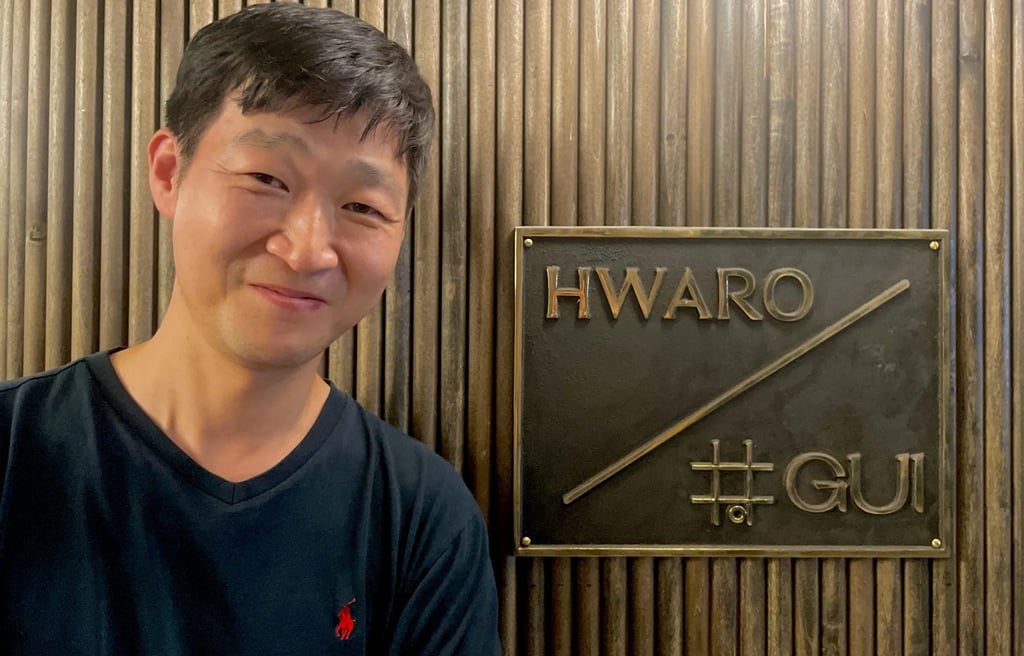Chef Sungchul Shim To Open Third Hell’s Kitchen Restaurant in Former Staples, as Local Asian Culture Flourishes
Gui is unassuming from the outside. Nestled on a busy stretch of 8th Avenue, the Korean steakhouse from Michelin star chef Sungchul Shim sits in a space that once belonged to a Staples. But inside, any memories of office supplies have long since faded, replaced by Shim’s biggest and most extravagant project yet.
Celia Young
8/17/20244 min read


Gui is unassuming from the outside. Nestled on a busy stretch of 8th Avenue, the Korean steakhouse from Michelin star chef Sungchul Shim sits in a space that once belonged to a Staples. But inside, any memories of office supplies have long since faded, replaced by Shim’s biggest and most extravagant project yet.
The restaurant is cavernous, spanning 10,000 square feet, two floors, and holding three destinations — cocktail lounge Bar 92, circular dining room Hwaro and the steakhouse floor. Gui is preparing to next month, and Shim is thrilled to join a growing community of new Asian restaurants in Hell’s Kitchen, including his other nearby eateries.
“This is like my life’s dream,” Shim said. “It’s very exciting.
On Gui’s first floor at 776 8th Avenue, you’ll find Bar 92, backed by a massive slab of black lacquer inlaid with mother-of-pearl. Here, Shim plans to highlight variations on classic cocktails from New York City bartender and beverage director Gelo Honrade.
The first floor Bar 92 features a mother-of-pearl inlaid lacquered slab. Photo: Celia Young
Upstairs sits Hwaro (화로), a circular dining room named after the term for a Korean stove. Its menu and design are emblematic of Korean hospitality: guests sit in a circle surrounding the central chef station — similar to another Shim restaurant, Mari — and Shim plans to serve up traditional Korean dishes blended with “global influences.”
Gui’s vast dining room overlooks 8th Avenue. The space feels impossibly quiet — no sounds from the busy thoroughfare seep through the walls. It’s a restaurant big enough to get lost in, and larger than Shim’s other Hell’s Kitchen eateries Mari and Kochi, both of which have earned a Michelin star.
Getting ready to open — Gui steakhouse’s dining room and circular Hwaro dining room (center) both located on the 2nd floor. Photos supplied
It’s also been a long time coming, said Shim, who spent more than two years looking for the perfect location and another few months negotiating the price. Jiwon Kim, Gui’s culinary director, said Shim made more than five trips to South Korea to hand-pick Gui’s silverware, plateware and decorations.
Converting a former Staples into a high-end eatery took time, but it also gave Shim a blank canvas to create his dream restaurant, said Gui’s General Manager Jason Lui. “He personally had to advocate and be an architect in a sense to create this space,” Lui said.
Chef Sungchul Shim with floor manager Awa Kane, general manager Jason Lui and culinary diretor Jiwon Kim. Photo: Celia Young
Gui is set to join a growing number of Asian restaurants in Hell’s Kitchen. The much-loved Japanese Udon eatery Raku opened its fourth location in the neighborhood for sit-down dining this month after offering takeout and delivery noodles since June. A number of omakase restaurants —including Omakase by Korami, Tatsuda Omakase, and Sushiichi — have opened here since 2021.
The neighborhood has long been home many popular Thai spots, said longtime resident Huey Kim. But a handful of new eateries have popped up in the past few years, including the Thai comfort food joint LumLum, which opened in 2022, and the more recent southern-style Thai restaurant Chalong. Plus, there are a few other new Korean eateries that have opened up since the 2020 pandemic, such as the Korean taco eatery UT47, fried chicken spot Koji Chicken and fusion restaurant Bulbap Grill.
Over the last few years, Hell’s Kitchen has seen an influx of Asian restaurants. Photos: Naty Caez and Phil O’Brien
Hell’s Kitchen has also seen a few new high-end eateries, such as the Chinese tasting menu restaurant Yingtao, or Chi, one of the pricier Chinese spots on 9th Avenue. The surge in new Chinese restaurants even led Eater to dub the neighborhood “another Chinatown” last year.
That growing high-end food scene has created more competition for Gui, though culinary director Kim said he was happy to have it.
“I used to say that our only competition is us, because Kochi and Mari are so close. And now we have more competition for sure, and that’s a good thing,” Kim said. “The food has evolved so much. When we first opened Kochi, it was just a deli on every single block.Those are turning into more restaurants now, with more options, more diverse cuisines.”
The new restaurant openings are great news for Evelyn Yang, an activist, Hell’s Kitchen mom, and wife of politician Andrew Yang.
“We’ve been really excited about the new assortment of Asian restaurants in the area and have been to many of them — we’re often at Chai, Chi, DD Soup Dumpling and Mari,” Yang said.
And it’s not just Hell’s Kitchen’s food scene that’s expanding — it’s the neighborhood itself. Hell’s Kitchen’s population grew by nearly 30 percent in the 10 years before 2020 according to census data, with its Asian residents growing by 74 percent — the most of any ethnic group — and the area broadly becoming more diverse, Patch reported.
That diversity is partly what drew Shim to open his third restaurant in the neighborhood. He wants Gui to be a destination for Hell’s Kitchen residents and tourists alike, even with its higher price tag.
“There’s a lot of diversity, a lot of young people, and then [there are] those who have lived here more than 20 or 30 years,” Shim said. “We’re trying to do something different from what they currently have.”
Gui
+1-646-329-5929
info@guinyc.com
Stay Connected with us
© 2025. All rights reserved.
@gui.nyc
@bar92nyc
GUI Hours:
Monday: ( L) 12-2:30pm / Dinner: 4pm-10pm
Tuesday-Saturday: (L) 12-2:30pm / Dinner: 4pm-10pm
Sunday: ( L) 12-2:30pm / Dinner: 4pm- 9pm
776 8th Ave, New York
2F - Gui Steakhouse
1F - Bar92
Bar 92 Hours:
Monday-Thursday: 12pm- 11pm
Friday- Saturday: 12pm- 12am
Sunday: 12pm- 10pm
Happy Hour: 4-7pm Everyday
Late Hour: 8pm- Closing Everyday
